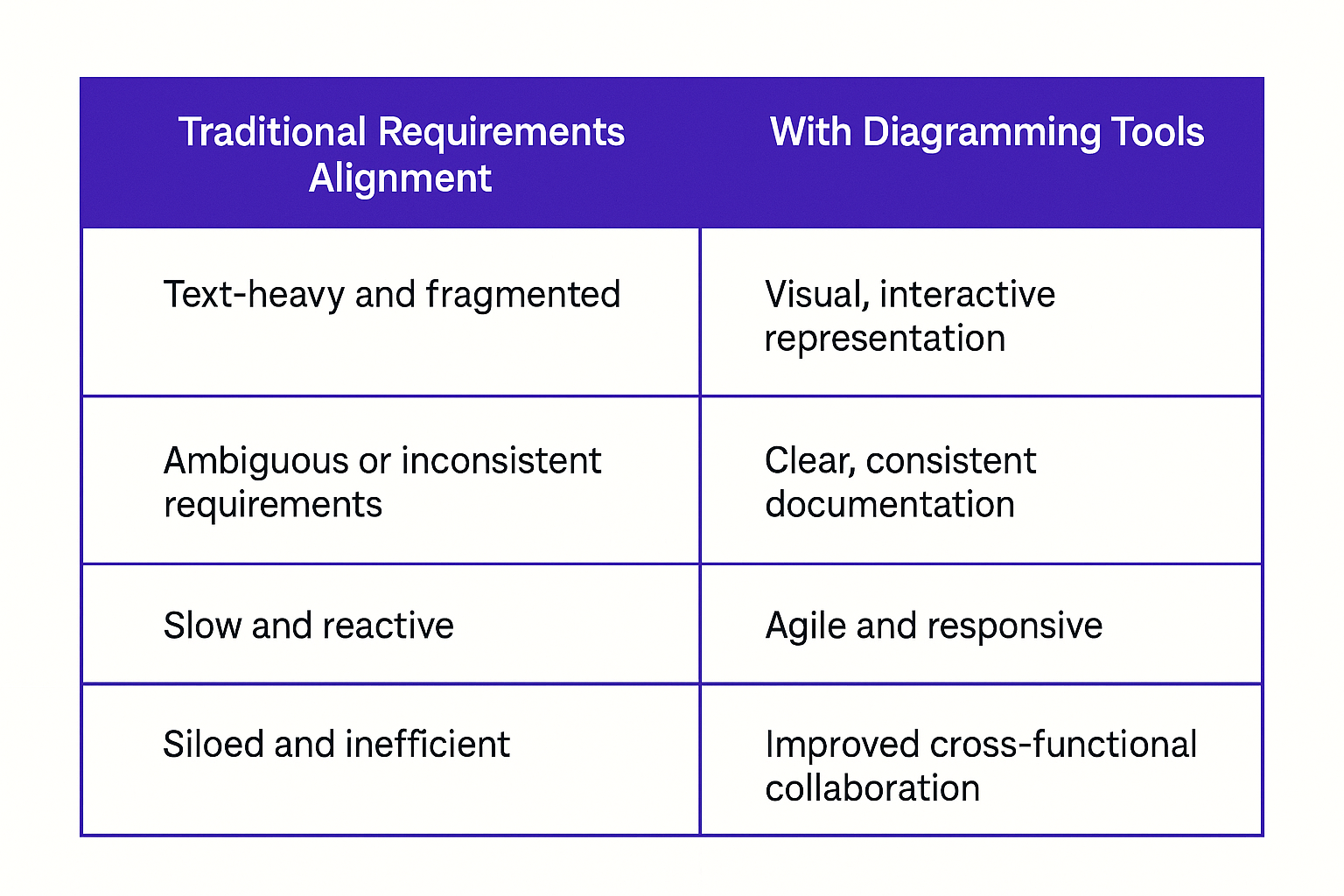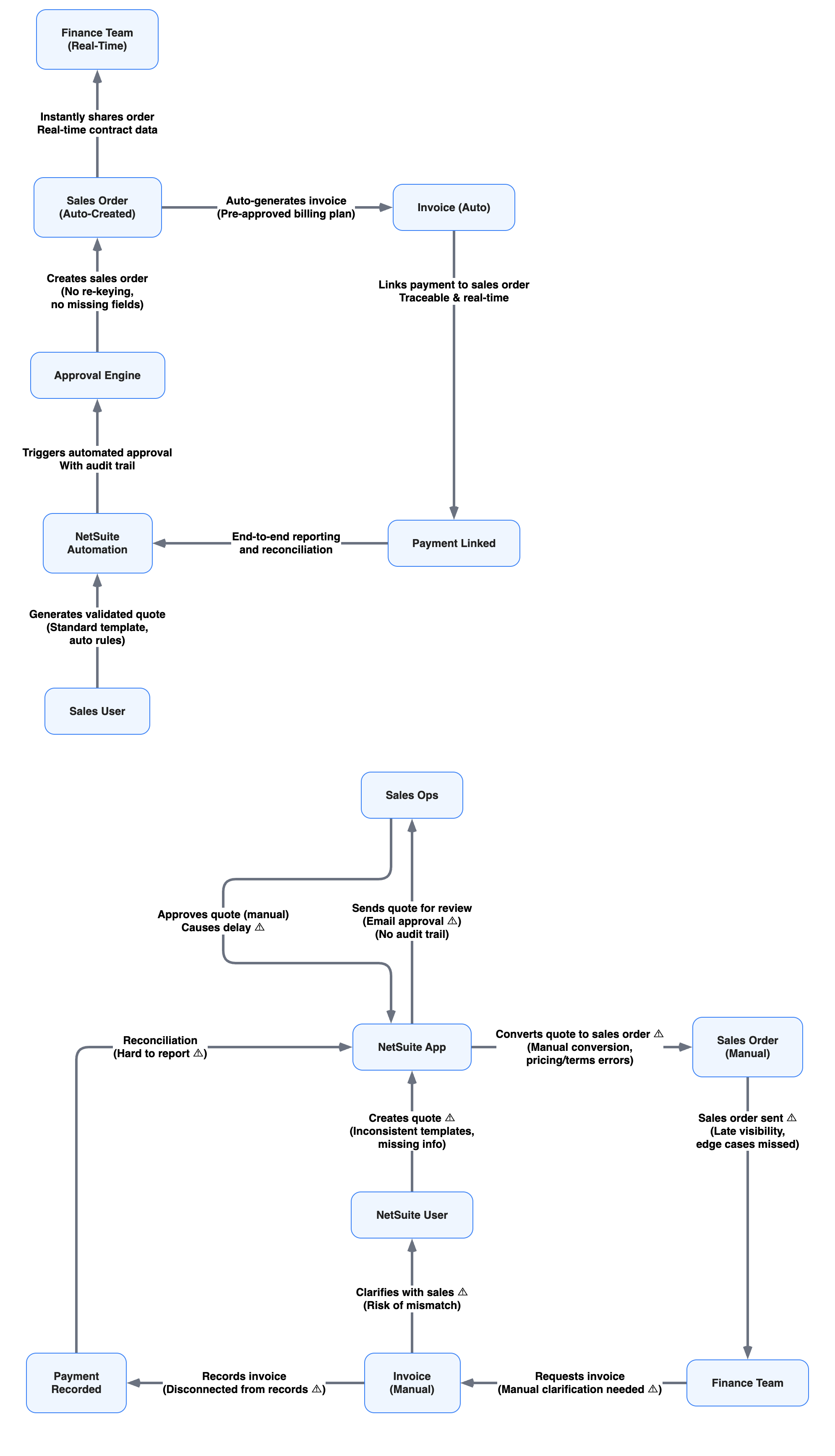How Salesforce and NetSuite Implementation Teams Can Save Time, Reduce Rework, and Align Faster
(Above: Current state (bottom) vs Future state (top) of Quote-to-Cash in Netsuite)
Implementing a system like Salesforce or NetSuite isn’t just about choosing the right technology; it’s about executing it without chaos. And that execution hinges on one of the most deceptively difficult steps: requirements alignment.
From discovery to deployment, implementation teams rely on the quality of their shared understanding. Yet all too often, that understanding lives in static documents, buried in Confluence pages, or scattered across diagrams, decks, and disconnected workflows.
This post offers a new approach: a visual template that shortens the time from initial discovery to deployable clarity. It’s designed specifically for NetSuite and Salesforce implementation teams, especially on the technical side, where precision and speed matter most.
Where Requirements Go Wrong
Even well-run implementation teams experience friction during the requirements phase. The problems aren’t always glaring. But they compound fast:
- Unclear handoffs between solution architects, business analysts, and dev teams
- Multiple versions of requirements in Google Docs, Confluence, or Jira tickets
- Functional and technical silos that create rework downstream
- Unmapped dependencies across teams, objects, or third-party systems
- Visual artifacts (e.g., Lucidchart or Miro) that become outdated or disconnected from source documentation
These aren’t process failures, they’re clarity failures. And in implementation work, clarity is everything.
Why Visual Clarity Matters in ERP and CRM Projects
When you’re dealing with something as complex and high-stakes as a Salesforce or NetSuite deployment, teams can’t afford misalignment between what was scoped and what gets built.
You need a shared map. Not a flat one, but a living one; something that shows how requirements connect, evolve, and cascade across systems, teams, and timelines.
That’s where visual templates come in.
What Is a Visual Requirements Template?
A visual requirements template is a structured diagram that captures the who, what, how, and why of a business flow across discovery, solutioning, configuration, and deployment.
It includes:
- Core flows and dependencies (e.g., quote-to-cash, lead-to-opportunity)
- Roles and actors involved in each stage
- System and integration points (NetSuite modules, Salesforce objects, middleware)
- Edge cases and exceptions
- Linked context (requirements text, comments, decisions)
Rather than creating static flowcharts in Miro or Lucidchart, which are typically exported and forgotten, this template becomes a source of truth that evolves alongside the implementation.
A Template That Works Across the Lifecycle
Here's how a visual requirements template helps across key stages of a NetSuite or Salesforce implementation:
Discovery
Quickly map current-state and future-state processes in real time. Identify mismatched expectations early. Get technical and functional stakeholders on the same page visually.
Solution Design
Turn diagrams into working blueprints. Align solution architects and developers with clear logic flows and edge case handling. Catch integration gaps before they’re coded.
Configuration
Use the diagram to generate stories or configuration checklists. Visual flows make it easier to understand object relationships, field mappings, and automation logic.
UAT & Deployment
Map test cases directly to the flows. Ensure nothing’s left untested. Quickly trace defects back to original requirements and make sure post-go-live support is ready.
Compared to the Status Quo: A Step Change

By contrast, a visual template built in a platform like Splotch:
- Keeps diagrams and text in sync
- Enables live collaboration across teams
- Supports versioning and change tracking
- Embeds directly in project workspaces
- Becomes a living document, not just a snapshot
How Implementation Teams Use Splotch to Align Faster
NetSuite and Salesforce implementation partners are increasingly turning to diagram-first tools like Splotch to bring order to complexity.
Here’s how it works in practice:
- Visual-first discovery workshops: Build flows live with stakeholders instead of taking notes and diagramming later.
- Linking text to diagram elements: Ensure that each step, actor, or condition is grounded in clear documentation.
- Collaborative iteration: Solution architects, dev leads, and QA can all comment, adjust, and align in one shared diagram.
- Diagram-to-deliverable mapping: Use the template to inform stories, configs, or test plans.
It’s not just better documentation, it’s faster alignment.
What Changes When You Align Visually
Shorter handoffs: Diagrams reduce the need for long meetings and handover sessions.
Less rework: Developers build what was actually intended, not what was implied in a bullet list.
Faster onboarding: New team members get up to speed quickly by tracing the diagram.
Improved stakeholder confidence: Clients understand what’s being built and why, before UAT.
Better reuse: Templates from one project become starting points for the next.
Align Early, Deploy Faster
You can’t eliminate complexity from ERP or CRM projects, but you can eliminate confusion.
When requirements are visual, not verbal, when they’re linked, not siloed, implementation teams move faster, make fewer errors, and deliver better outcomes.
For Salesforce and NetSuite consultancies working at scale, this isn’t just a nice-to-have. It’s how you stay competitive.
Ready to see how it works?
Start diagramming your next requirements session instead of writing it. See what your team can build when alignment comes first. Get Splotching.
